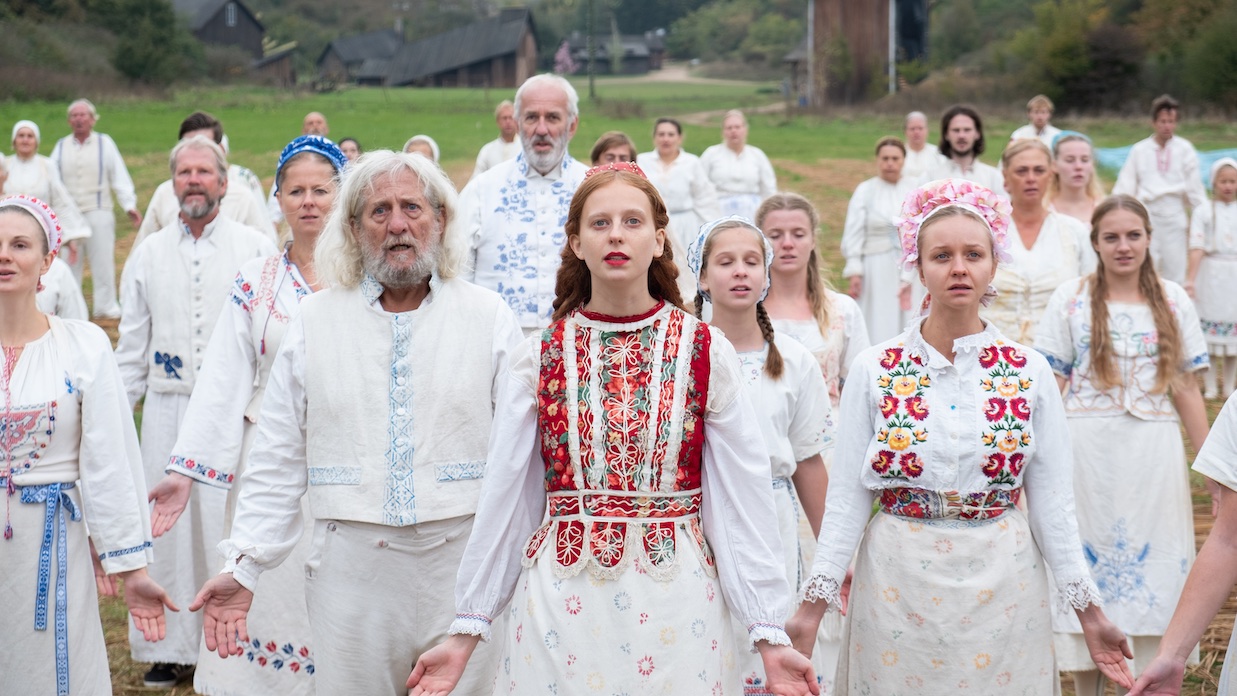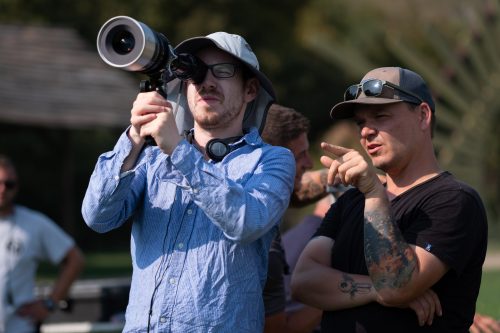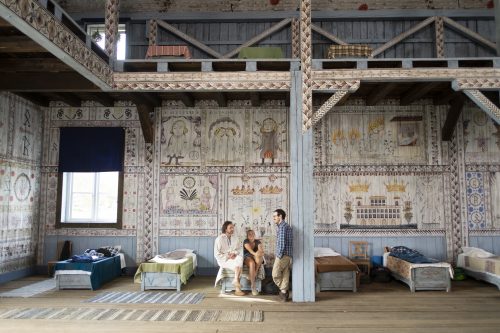 Back to selection
Back to selection
The Unsettling Glow of Daylight: DP Pawel Pogorzelski on Shooting the Folk Horror of Midsommar
 (Center) Isabelle Grill
Photo by Csaba Aknay, Courtesy of A24
(Center) Isabelle Grill
Photo by Csaba Aknay, Courtesy of A24 In the span of just two features, writer/director Ari Aster and cinematographer Pawel Pogorzelski have forged a signature style that cloaks the heightened emotions of melodrama behind the veil of the horrific. In last year’s Hereditary, the Ordinary People-esque family tragedy unfolded in a haunted house, where a matriarch’s sense of being cursed manifested itself literally. In the new film Midsommar, the crumbling relationship between two American grad students plays out against the backdrop of an isolated Swedish community whose harvest festival isn’t quite as benign as it first appears.
With Midsommar out now in wide release, Pogorzelski talked to Filmmaker about shooting horror in the mid-day sun, using different lenses for different segments of the story, and utilizing his actors as “walking bounces.”
Filmmaker: The majority of Midsommar takes place in a Swedish village where the summer sun only fleetingly sets. What are the difficulties that come with shooting a movie almost entirely under harsh toplight?
Pogorzelski: It was a crazy challenge. My first thought was to cover [the actors with overhead diffusion], but once I saw the size of the field during our scout I knew that option was definitely gone. There was a lot of testing to try and figure out what we could do to control the sunlight and the best time of day to shoot. We did a lot of sun scouting where we’d be in the field with a stand-in and take a photo every 15 minutes to see how the sun reacted. It was just a lot of trial and error and heavy prep.
Filmmaker: How many usable hours of sunlight did you get per day since dawn and dusk didn’t fit your mid-day look?
Pogorzelski: We shot French hours most of the time, which is where you work through lunch and you have a 10-hour day. So our call time would be 7:00 AM and usually we’d wrap around 5:00 PM. The sun would rise where we were shooting around 4:30 AM so by the time we were ready to [roll the camera] around 8:00 AM the sun was pretty high in the sky. Same thing when we wrapped — the sun was still pretty high in the sky.

Filmmaker: Did you use any movie lights for the exteriors?
Pogorzelski: The only time we used movie lights was in tighter coverage when the sun was disappearing at the end of the day. Since we were surrounded by hills, the sun would sometimes dip below the hills [as we were shooting a scene] and we’d have to take out the movie lights [to match the mid-day look]. Otherwise we just had three 20′ x 20′ frames on the ground — two with muslin and one with Ultra Bounce — that we moved around accordingly to bounce in light and that’s how we controlled the contrast.
Filmmaker: Were the white smocks of the villagers difficult to deal with?
Pogorzelski: They were dressed in this muslin-like material so it was actually great for me. It was like having walking bounces everywhere. (laughs) And I loved the challenge of shooting people dressed in white in pure sunlight, just to see if we could pull it off.
Filmmaker: So if you were doing an over, you could basically position the off-camera actor so that their costume served as a bounce for fill light?
Pogorzelski: Exactly, and it would feel natural in a beautiful way.
Filmmaker: What lenses did you use for Midsommar?
Pogorzelski: For all the early scenes set in the USA, we used Panavision Primo Prime lenses that were detuned a little bit. Once we get to [the part of the story set in the Swedish village of] Hårga we jump into the Panavision Primo Artiste 70mm lenses. We shot everything on the Panavision DXL2, but we shot 8K for the 70mm portion and 5K with the traditional 35mm Primo lenses. For the Primo Primes, our go-to lenses were the 27mm and 32mm. Then when we went to the Artistes the [equivalent lenses for the largest format’s] field of view became the 40mm and 50mm.
Filmmaker: What stop did you live at for the exteriors?
Pogorzelski: Because I wanted people to experience the whole environment and because the blocking was very intricate, I tended to live at a T4 or T4/5.6 just to be able to get more depth. But even at that stop the large format lenses gave me beautiful soft fall-off.
Filmmaker: You used the Alexa on Hereditary. Why the move to the Panavision digital camera for Midsommar?
Pogorzelski: Very early on we had some conversations about potentially shooting this movie on film, but, knowing how much we like to shoot and how many takes we do, our producer Lars [Knudsen] was worried about film so he wanted us to test it. So we did tests early last year, before we had even started prep on Midsommar. We tested the Alexa, 35mm film, and the DXL2, which was an upgrade from the DXL with a bit better color science and better latitude. When the footage came back and we looked at it projected on a big screen, the DXL2 was the one that we reacted to the most.
Filmmaker: Ari likes to do a lot of takes, but not a lot of coverage. And the coverage he does is very well thought out ahead of time through shot lists. How detailed are those lists?
Pogorzelski: They’re very complicated. Ari will write an initial shot list for the entire movie on his own with all these elaborate blockings and camera moves. Then we sit down in prep, go over those shot lists, and sketch out what the locations look like from these bird’s eye view plans that show how the actors and the cameras will move through the spaces. That helps us visualize things like which walls will potentially need to be moved for shots and what parts of the location are going to be seen on camera.
Filmmaker: When you first saw Ari’s list for Midsommar, what shot stood out right away as a challenge?
Pogorzelski: There’s a shot toward the end of the movie where we track with a wheelbarrow to the [village’s] yellow temple that I knew was going to be very complicated. The shot ended up getting cut a little bit in [the final movie], but it actually went on for another 15 seconds. It was a very intricate move. I think we used 400 feet of dolly track with a 40-foot crane and an 11-to-1 zoom on the camera. It took the grips four hours to build the track and another hour to level it. It kept sinking in the ground as the crane would travel on the track so they had to reinforce the leveling. Then it took four hours to shoot it. So that shot was crazy.
Filmmaker: On the flip side, there’s always seems to be a scene that looks simple on paper but ends up being a pain in the ass. Did you have a scene like that in Midsommar?
Pogorzelski: It was the scene where Christian [Jack Reynor] tells his friends that Dani [Florence Pugh] is coming to Sweden with them. It seemed like a simple scene, but we just couldn’t get it right. We kept fighting it and it just wasn’t working for us. Thankfully we were able to reshoot the scene later on.
Filmmaker: A big chunk of that scene plays in wide shot with Christian seen in a mirror, right?
Pogorzelski: Exactly, yeah, that’s the one. We shot it totally differently the first time and then we just simplified [when we re-shot] and it made it much better.

Filmmaker: Let’s talk about some of the interiors in Hårga. Those are practical interiors built inside the structures?
Pogorzelski: Yeah. The whole thing — inside and out — was a set.
Filmmaker: Tell me about lighting the structure that houses the community’s sacred text. There’s one skylight above the altar where the book rests and the interior, unlike the other spaces in the village, is black.
Pogorzelski: Yeah, it’s charcoal black. I wanted to have it quite dark so I could really control the contrast by the amount of light I let in. We had an 18K on a condor coming down through the skylight and onto the altar. Then right above that light we had a 20′ x 20′ frame with another 18K bouncing into it just to push in some soft light. On a sunny day, there’s not just light directly from the sun. There’s also ambiance. So we tried to reproduce that effect with the bounce.
Filmmaker: There’s a shot when the Americans are first driving to Hårga where a drone flies from the front of the car to the back. As the drone moves, the camera rotates 180 degrees so that the image is upside down when it reaches the other side of the vehicle. I don’t remember ever seeing that shot before.
Pogorzelski: We found very good drone operators in Hungary, where the Sweden-set scenes were filmed, but at first they told us it was impossible to do that shot. I kept doing research and found a way, which was basically a custom-made drone with a gimbal head — I think it was a Ronin — that could hold an Alexa Mini. Then you had to bypass the drone’s software to tell it to tilt more than [the software] would normally allow. I asked the drone operators if they would try that for me and they were a bit reluctant because that drone is their baby. The first day we flew it, the drone died as it took off. So we had to do the shot again on a day that was a little bit too overcast, but it was the only day we had left to get the shot. It was very windy, but the operators were able to keep the drone flying straight, which was quite impressive. I think we did it four or five times and every time [the drone operators] were very nervous. I was always like, “One more, one more. We can do it better.” And they were always like, “Are you sure? I think we’ve got it.” (laughs)
Filmmaker: The story begins to shift into something more sinister during a ritual involving two village elders and a cliff. The ceremony takes place on a large patch of white sand and it’s the one time in the film where you really let the highlights get super hot.
Pogorzelski: I fell in love with that location when I saw it. I thought it was so cool that the white [sand] matched the color of the costumes. It made it feel like this celebration was taking place in a sacred environment. Because we were shooting down in a hole [below the cliff], we had even less sunlight each day than normal. It was a nightmare for continuity, but thankfully we had three days scheduled for that scene, though we did get rained out and lost one of those days. When you’re outside in these gigantic spaces you’re just hoping that you have the weather cooperate with you, but you have no control over that.
Filmmaker: Like Hereditary, Midsommar uses a 2:1 aspect ratio, which falls right in between the more traditional ratios of 1.85 and 2.40. What do you like about composing in that frame?
Pogorzelski: We really fell in love with it on Hereditary. Before that we’d shot everything we’d done together in 1.85. For Midsommar, we were thinking of maybe shooting 2.40. Ari thought we could get more people in the frame horizontally for our wide shots, but I thought the vertical space was very important because of the mountains (surrounding the community) and the height of the buildings. To see all that information we settled at 2.1 for the aspect ratio.
Filmmaker: The scores in Ari’s films do a great deal of mood-setting. How does the way he uses music influence the way you approach a scene? For example, there’s a moment in Midsommar where the American tourists eat these miniature pies. It’s a bright, sunny day and there’s nothing ominous about the frame, yet the score adds this undertone of menace.
Pogorzelski: Ari usually knows what the music is going to be [before we shoot]. For Hereditary and Midsommar we even had some tracks from the composers beforehand. It’s really wonderful to have an idea of what kind of world the audio is going to live in so that you can let the audio take over at certain points and at other points I can take over with more dramatic lighting. Ari and I talk about that in preproduction so I know which scenes I won’t have to do anything because the music is already doing so much.
Matt Mulcahey works as a DIT in the Midwest. He also writes about film on his blog Deep Fried Movies.
